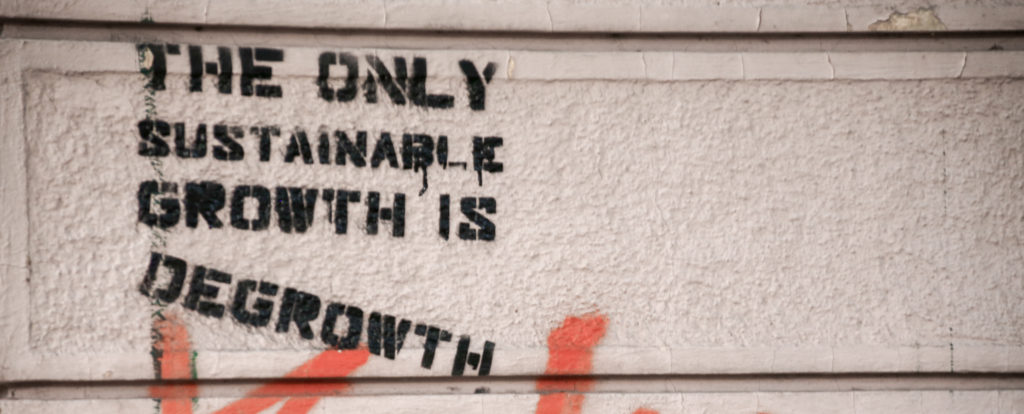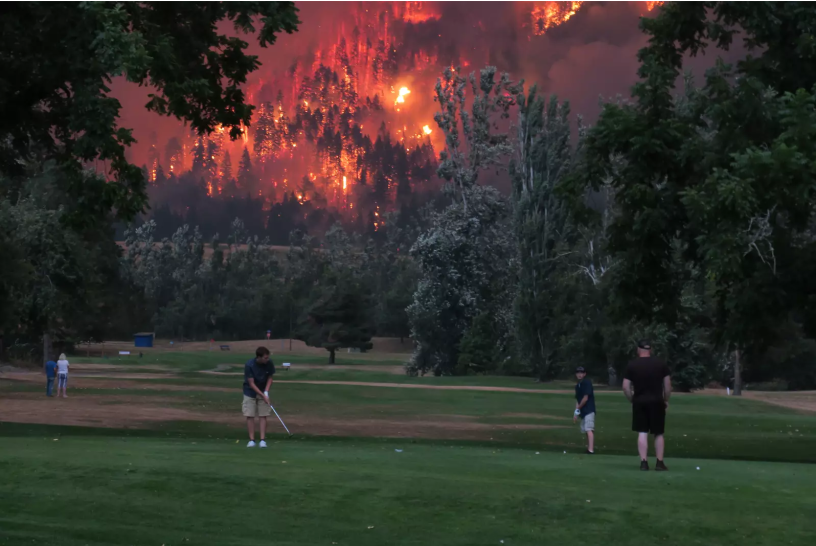The climate question is all about the limits. Carbon budgets, tipping points, ticking clocks and planetary boundaries are just some buzzwords flying around in talks about a menacingly waltzing climate change. This has always been a problem, as the main goal of most countries is economic growth: unlimitedness of a social system meets planetary limits.
From limits to growth to the birth of Green Growth
This dilemma was noticed as early as 1972. The Club of Rome report “Limits to Growth” marked the beginning of thinking that there could be inherent limits to the ways carbon-dependent societies are functioning. But already with the political neo-liberal climate of the 1980s and 1990s, the notion of “limits to growth” vanished from public discourse. The idea of a Green Growth was born, arguing there could be both: economic growth AND environmental protection.

The key to a sustainable future would be investments in innovations in new, more efficient technologies, with renewable energy sources and recycling-systems.
The appeal of Green Growth
It’s not hard to imagine that such an “easy way out” has had a big appeal to policy-makers and economists. Green Growth can be seen as business as usual, with a little nudge here and there towards green technologies. Problem solved.
This idea survived: Green New Deals in Europe and the US explicitly couple the aim of environmental protection with the premise of growth and job creation. The hope is that “protection pays”. All major policy agreements and international organisations follow the idea of Green Growth, sometimes reformulated as Ecological Modernization, Green Economy or Sustainable Growth/Development.
In the mid of the 2000s, the idea of limits to growth reappeared as “Degrowth”, fueled both by academia and activists. Proponents argue that the world is obsessed with the idea of growth. Meanwhile, Green-growthists call the idea of the end of growth naïve and ask whether they would want us to go back to the “stone age”. While all this feels like the old left- and right-debate, it’s more complicated. Degrowth and Green Growth are not naturally linked to any political position. Degrowthists all follow some critique on the capitalist system, though with different moral foundations, but there the unity ends. Dennis Eversberg and Matthias Schmelzer have found that Degrowth activists are parted to at least five different fractions in Germany alone, ranging from conservative and sufficiency-oriented to anti-capitalist and post-colonial positions. On the other hand, Green Growth is, in political practice, as much a concept for the liberals as well as the greens and left parties.
Degrowth: why do we need growth, again?

Degrowth, in short, means a reduction of consumption and production, which would result in a reduction of the GDP, as a way of achieving sustainability, social justice and welfare. GDP-growth would not guarantee social welfare. Supporters of this idea rather want to safeguard both the climate and social welfare through cultural change towards sufficiency and by adopting re-distribution policies, together with said technological innovations.
Growth, especially GDP-growth would be a false “proxy” to welfare. Therefore, many degrowthists call for other welfare indicators to be implemented. They argue that research shows that beyond a certain threshold, GDP rise would not generate more happiness or well-being. And much of the GDP-growth in the past years flowed into the pockets of the rich, anyway. Furthermore, from a global justice perspective, if industrialized countries still insist on economic growth, they diminish the possibility of other countries for economic growth within planetary limits.
Decoupling or non-consumption
Empirical studies do reject the theory that green growth is feasible. Green Growth proponents would be too naive and overly optimistic when it comes to technological advancements and their possible impact on absolute decoupling. Decoupling means that the rise in production and consumption is not coupled with rising CO2-emissions.
Most decoupling nowadays is relative, meaning that less CO2 is needed to generate a dollar of GDP – but it’s not zero. While some countries do have rates of absolute decoupling, this is mostly due to outsourcing. Especially for some industry sectors, becoming carbon neutral is still a long way down. And simply moving the dirty industry to another country does not solve a global problem.
Technological optimism and rebound effects
This technological optimism can be also seen in international treaties and scientific climate scenarios. The Paris Agreement and IPCC scenarios are counting on negative emissions, for example BECCS. The problems are, these technologies 1. are not that advanced and secured to be ready to use, 2. are literally burying the problem, 3. have uncertain risks. Much of this resembles a debate that we have been having for half a century now: nuclear energy.
Furthermore, rebound effects are bound to step in place: You know that situation when you got something on sale and then decided to buy something else with the money you saved? The rebound-effect is exactly this. Sociologists found evidence that most of the technological advancements in efficiency have been swallowed up by adapted consumption behaviour. In the same manner, increased incomes do normally correlate with a higher personal CO2-footprint.
The same effect can be seen on the macro-level of society: rising returns, e.g. from gains in efficiency, are reinvested in further production. Who wonders? This is a key mechanism of capitalism and it works the same for green innovation.
Beyond the stalemate: Agrowth?
What both Green Growth and Degrowth have in common is the goal that there is the need to cut down CO2-emissions resulting from our economic activities. The problem presented here is that both sides seem to be categorically fighting for their theoretical claim, without the will to negotiate. Jerome van den Bergh argues that “Agrowth” would be a viable, non-ideological way of cruising past this stalemate.
In simple terms, we just would not care whether we grow or not. Anything goes, as long as it helps solving the climate crisis and secure welfare. With uncertainty about the future of consumption behaviour, innovations and decoupling rates, this would be the most “secure” approach. In practice, probably technological advancements, a change in consumption-behaviour, and in the overall macro-economic structure are all needed.
Rather imagining the end of the world

It has to be said that many degrowthists in the meantime have adopted a similar definition of their theory, which makes it all the more confusing. What is becoming obvious is that being indifferent about growth could refocus our attention to the real goals.
But it’s not that easy. The “growth”-debate runs deeper. It is a proxy to both a critique of and a plea for a capitalist system. We should not miss that “growth” is more than just a figure, but a historically grown construct. The idea that “growth” essentially means something good is inherited in our language, our thinking, our routines, our economic theory, our institutions, our statistics. It does not disappear overnight. Neither can politicians ignore it in the next climate negotiations. It makes us preoccupied.
Mark Fisher once coined the term capitalist realism – “now it is easier to imagine an end to the world than an end to capitalism”. Without arguing that we must end it at all cost, we should nevertheless ask more deeply about the roots of the multiple crises, be it ecological, social or political. Regardless of the labels “Agrowth” or “Degrowth”, societies and political actors cannot stay preoccupied by non-negotiable standpoints any longer in order to be able to imagine sustainable and just futures.
Sources:
Eversberg, Dennis; Schmelzer, Matthias (2015): Degrowth: Kapitalismuskritik muss praktisch werden! Grundkonsens und Differenzen einer entstehenden Bewegung.
Fisher, Mark (2010): Capitalist Realism: Is There No Alternative?. Winchester, UK: Zero Books.
https://www.greeneuropeanjournal.eu/green-growth-vs-degrowth-beyond-a-sterile-debate/
Hickel, Jason; Kallis, Giorgos (2020): Is Green Growth Possible?, New Political Economy, 25:4, 469-486, DOI: 10.1080/13563467.2019.1598964
Hajer, Marteen (1995): The Politics of Environmental Discourse.
Jackson, Tim (2017): Prosperity without Growth. Routledge
Meadows, D. H., Meadows, D. L., Randers, J. & Behrens, W. W. (1972): The Limits to Growth, Universe Books.
Markantonatou, Maria (2013): From The Limits to Growth to “Degrowth”: Discourses of Critique of Growth in the Crises of the 1970s and 2008. Working Paper 05/2013 der DFG-KollegforscherInnengruppe Postwachstumsgesellschaften.
https://www.nachhaltigkeit.info/artikel/degrowth_1849.htm
https://www.nachhaltigkeit.info/artikel/green_growth_green_economy_green_new_deal_1842.htm
https://www.nytimes.com/2019/02/21/climate/green-new-deal-questions-answers.html
Paech, N. (2012b): Liberation from Excess. The Road to a Post-Growth Economy, Oekom-Verlag, Munich.
https://www.postwachstum.de/klimaschutz-und-green-growth-sind-unvereinbar-20140725
https://www.unenvironment.org/explore-topics/green-economy
van den Bergh, J. (2017): A third option for climate policy within potential limits to growth. In: Nature Clim Change 7, 107–112. https://doi.org/10.1038/nclimate311